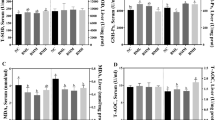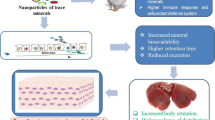Abstract
A green and ecofriendly bio-based synthesis of nano selenium particles was performed using the Bacillus subtilis and the products were characterized by field emission scanning electron microscope (FESEM), dynamic light scattering (DLS) and transmission electron microscopy (TEM) methods. Dietary treatments included a control diet nonsupplemented with selenium and control diet supplemented with different sources of selenium (sodium selenite, organic Se, and nano-bio Se), resulting in a total of 4 treatments with 6 replicates of 10 chicks. Broilers were assessed for performance measures, ileum morphometry, and microbial population and jejunum tight junction proteins’ relative expression. The particle size of the synthesized selenium nanoparticles ranges 40 to 150 nm, with crystalline spherical shape. Inclusion of selenium increased body weight (BW) and improved FCR compared to the control diet (P < 0.05). Among the selenium sources, the highest BW were achieved in chicks fed sodium selenite or nano-bio Se. Selenium supplementation meaningfully (P < − 0.01) changed ileum morphology and reduced ileum microbiota. Inclusion of selenium increased the relative weight of the carcass, breast, and thigh and reduced the relative weight of the liver and bursa of Fabricius on day 42 (P < 0.01). The relative length of duodenum, jejunum, and ileum were increased on day 14 but reduced on day 42 by inclusion of selenium (P < 0.05). Supplementation of selenium increased (P < 0.01) the expression of claudin-1, occludin, and zonula occluden-1 and reduced (P < 0.01) the expression of claudin-5 and zonula occluden-2 on day 28. Inclusion of nano-bio selenium increased (P < 0.05) the expression of occludin, zonula occluden-1, and zonula occluden-2 and reduced (P < 0.05) the expression of claudin-5 compared to the organic selenium and sodium selenite on day 42. In conclusion, this data suggest feasibility of the biosynthesis of selenium nanoparticles by Bacillus subtilis. Additionally, the data reported herein demonstrate that nano-bio selenium can effectively improve performance and intestinal integrity compared to the common organic and inorganic sources of selenium.








Similar content being viewed by others
Data Availability
The data of this study will be made available on reasonable request.
References
Bakhsgalinejad R, AkbariMoghadamkakhi R, Zoidis E (2018) Effects of different dietary sources and levels of selenium supplements on growth performance, antioxidant status and immune parameters in Ross 308 broiler chickens. Br Poult Sci 59:81e–891
Bakhsgalinejad R, Hassanabadi A, Swick RA (2019) Dietary sources and levels of selenium supplements affect growth performance, carcass yield, meat quality and tissue selenium deposition in broiler. Anim Nutr 5:256e–2263
Mahan D, Cline T, Richert B (1999) Effects of dietary levels of selenium-enriched yeast and sodium selenite as selenium sources fed to growing-finishing pigs on performance, tissue selenium, serum glutathione peroxidase activity, carcass characteristics, and loin quality. J Anim Sci 77:2172e–9
Kasaikina MV, Kravtsova MA, Lee BC, Seravalli J, Peterson DA (2011) Dietary selenium affects host selenoproteome expression by influencing the gut microbiota. The FASEB J 25(7):2492–2499
Naylor A, Choct M (2000) Effects of selenium source and level on performance, mortality and meat quality in male broilers. Asian-Australas J Anim Sci 12:125e–8
Payne R, Southern L (2005) Comparison of inorganic and organic selenium sources for broilers. Poult Sci 84:898e–8902
Oliveira T, Rivera D, Mesquita F, Braga H, Ramos E, Bertechini A (2014) Effect of different sources and levels of selenium on performance, meat quality, and tissue characteristics of broilers. J Appl Poult Res 23:15e–122
Zhao L, Sun LH, Huang JQ, Briens M, Qi DS, Xu SW, Lei XG (2017) A novel organic selenium compound exerts unique regulation of selenium speciation, selenogenome, and selenoproteins in broiler chicks. J Nutr 147:789–797
Sun LH, Huang JQ, Deng J, Lei XG (2019) Avian selenogenome: response to dietary Se and vitamin E deficiency and supplementation. Poult Sci 98:4247–4254
Yusof HM, Mohamad R, Zaidan UH, Abdul Rahman NA (2019) Microbial synthesis of zinc oxide nanoparticles and their potential application as an antimicrobial agent and a feed supplement in animal industry: a review. J Anim Sci Biotechnol 10:57. https://doi.org/10.1186/s40104-019-0368-z
Swain PS, Rao SBN, Rajendran D, Dommic G, Selvaraju S (2016) Nano zinc, an alternative to conventional zinc as animal feed supplement: a review. Anim Nutr 2:134e–1141
Kulkarni SC, Patil DS (2016) Synthesis and characterization of uniform spherical shape nanoparticles of indium oxide. J Mater Sci Mater 27:3731–3735
Cho JH, Upadhaya SD, Kim IH (2015) Effects of dietary supplementation of modified zinc oxide on growth performance, nutrient digestibility, blood profiles, fecal microbial shedding and fecal score in weanling pigs. Anim Sci J 86:617–623. https://doi.org/10.1111/asj.12329
Tsai YH, Mao SY, Li MZ, Huang JT, Lien TF (2016) Effects of nanosize zinc oxide on zinc retention, eggshell quality, immune response and serum parameters of aged laying hens. Anim Feed Sci Technol 213:99–107. https://doi.org/10.1016/j.anifeedsci.2016.01.009
Shah M, Fawcett D, Sharma S, Tripathy SK, Poinern GEJ (2015) Green synthesis of metallic nanoparticles via biological entities. Materials (Basel) 8(11):7278–7308. https://doi.org/10.3390/ma8115377
Ghiuţă I, Cristea D, Croitoru C, Kost J, Wenkert R, Vyrides I, Anayiotos A, Munteanu D (2018) Characterization and antimicrobial activity of silver nanoparticles, biosynthesized using Bacillus species. Appl Surf Sci 438:66–73
Nanda A, Saravanan M (2009) Biosynthesis of silver nanoparticles from Staphylococcus aureus and its antimicrobial activity against MRSA and MRSE. Nanomed-Nanotechnol 5:452–456
Singh R, Wagh P, Wadhwani S, Gaidhani S, Kumbhar A, Bellare J, Chopade BA (2013) Synthesis, optimization, and characterization of silver nanoparticles from Acinetobacter calcoaceticus and their enhanced antibacterial activity when combined with antibiotics. Int J Nanomed 8:4277–4290
Korrbekandi H, Iravani S, Abbasi S (2012) Optimization of biological synthesis of silver nanoparticles using Lactobacillus casei subsp. casei. J Chem Technol Biotechnol 87:932–937. https://doi.org/10.1002/jctb.3702
Li J, Li Q, Ma X, Tian B, Li T, Yu J, Dai S, Weng Y, Hua Y (2016) Biosynthesis of gold nanoparticles by the extreme bacterium Deinococcus radiodurans and an evaluation of their antibacterial properties. Int J Nanomed 11:5931–5944
Devi LS, Joshi SR (2015) Ultrastructures of silver nanoparticles biosynthesized using endophytic fungi. J Microsc Ultrastruct 3(1):29–37
Velusamy P, Kumar GV, Jeyanthi V, Das J, Pachaiappan R (2016) Bio-inspired green nanoparticles: synthesis, mechanism, and antibacterial application. Toxicol Res 32(2):95–102
Avazkhanloo M, Shahir MH, Khalaji S, JafariAnarkooli I (2020) Flaxseed extrusion and expansion coupled with enzyme and pelleting changed protein and lipid molecular structure of flaxseed and improved digestive enzymes activity, intestinal morphology, breast muscle fatty acids and performance of broiler chickens. Anim Feed Sci Technol 260:114341
Bryant M, Burkey L (1953) Numbers and some predominant groups of bacteria in the rumen of cows fed different rations. J Dairy Sci 36:218–224
Amerah AM, Ravindran V, Lentle RG (2008) Thomas. Influence of particle size and xylanase supplementation on the performance, energy utilisation, digestive tract parameters and digesta viscosity of broiler starters. Br Poult Sci 49:455–462
Livak KJ, Schmittgen TD (2001) Schmittgen. Analysis of relative gene expression data using real-time quantitative PCR and the 2-ΔΔCT method. Methods 25:402–408. https://doi.org/10.1006/meth.2001.1262
SAS, INSTITUTE (2003) SAS Users Guide: Statistics, Version 9.1 ed. SAS Inst, Cary
Avendaño R, Chaves N, Fuentes P, Sánchez E, Jiménez JI, Chavarría M (2016) Production of selenium nanoparticles in Pseudomonas putida KT2440. Sci Rep 15(6):37155
Dlohá G, Ševčíková S, Dokoupilová A, Zita L, Heindl J, Skřivan M (2008) Effect of dietary selenium sources on growth performance, breast muscle selenium, glutathione peroxidase activity and oxidative stability in broilers. Czech J Anim Sci 53:265–269
Cai SJ, Wu CX, Gong LM, Song T, Wu H, Zhang LY (2012) Effects of nano-selenium on performance, meat quality, immune function, oxidation resistance, and tissue selenium content in broilers. Poult Sci 91:2532–2539. https://doi.org/10.3382/ps.2012-02160
Silva VA, Clemente ABS, Nogueira BRF, de Carvalho AC, de Freitas LFVB, de Ramos A, LS, ad Bertechini AG, (2019) Supplementation of selenomethionine at different ages and levels on meat quality, tissue deposition, and selenium retention in broiler chickens. Poult Sci 98:2150–2159
Medeiros LG, Oba A, Shimokomaki M, Pinheiro JW, Silva CA, Soares AL, Pissinati MA (2012) Desempenho, Características de carcaça e qualidade de carne de frangos de corte suplementados com selênio orgânico. Semina Ciênc Agrár 3:3361–3370
Boiago MM, Borba H, Leonel FB, Giampietro –Ganeco A, Ferrari FB, Stefani LM, Souza PA (2014) Sources and levels of selenium on breast meat quality of broilers. Cienc Rural 44:1692–1698
Rajashree K, Muthukumar T, Karthikeyan N (2014) Influence of inorganic and organic selenium sources on broiler performance and meat quality. Iran J Appl Anim Sci 4:151–157
Cardoso BR, Roberts BR, Bush AI, Hare DJ (2015) Selenium, selenoproteins and neurodegenerative diseases. Metallomics 7:1213
Navarro-Alarcon M, Cabrera- Vique C (2008) Selenium in food and the human body: a review. Sci Total Environ 400:115–141
Turanov AA, Xu XM, Carlson BA, Yoo MH, Glandyshev VN, Hatfield DL (2011) Biosynthesis of selenocysteine, the 21st amino acid in the genetic code, and a novel pathway for cysteine biosynthesis. Adv Nutr 2:122–128
Yoon I, Werner TM, Butler JM (2007) Effect of source and concentration of selenium on growth performance and selenium retention in broiler chickens. Poult Sci 86:727–730
Li JL, Zhang L, Yang ZY, Zhang ZY, Jiang Y, Gao F, Zhou GH (2018) Effects of different selenium sources on growth performance, antioxidant capacity and meat quality of local Chinese Subei chickens. Biol Trace Elem Res 181:340–346. https://doi.org/10.1007/s12011-017-1049-4
Foster LH, Sumar S (1995) Selenium in the environment, food and health. Nutr Food Sci 5:17–23
Robinson MF, Thomson CD (1983) The role of selenium in the diet. Nutr Rev 53:3–26
Chen J, Tellez G, Richards JD, Escobar J (2015) Identification of potential biomarkers for gut barrier failure in broiler chickens. Front Vet Sci 2:14
Kops SK, Lowe DK, Bement WM, West AB (1996) Migration of Salmonella typhi through intestinal epithelial monolayers: an in vitro study. Microbiol Immunol 40:799–811
Zhang B, Shao Y, Liu D, Yin P, Guo Y, Yuan J (2012) Zinc prevents Salmonella enterica serovar Typhimurium-induced loss of intestinal mucosal barrier function in broiler chickens. Avian Pathol 41:361–367
Gîlcă-Blanariu GE, Diaconescu S, Ciocoiu M, Ştefănescu G (2018) New insights into the role of trace elements in IBD. Biomed Res Int 1813047. https://doi.org/10.1155/2018/1813047
Brenes A, Marquardt RR, Guenter W, Viveros A (2002) Effect of enzyme addition on the performance and gastrointestinal tract size of chicks fed lupin seed and their fractions. Poult Sci 81:670–678
Downs K, Hess J, Bilgili S (2000) Selenium source effect on broiler carcass characteristics, meat quality and drip loss. J App Anim Res 18:61e–671
Martin TA, Das T, Mansel RE, Jiang WG (2006) Synergistic regulation of endothelial tight junctions by antioxidant (Se) and polyunsaturated lipid (GLA) via claudin-5 modulation”. J Cell Bioch 98:1308–1319
Eichner M, Protze J, Piontek A, Krause G, Piontek J (2017) Targeting and alteration of tight junctions by bacteria and their virulence factors such as Clostridium perfringens enterotoxin”. Pflügers Archiv - European J Physiol 469:77–90
Acknowledgements
The authors would like to acknowledge the research support obtained from Bonda Faravar for his great help in nanoparticles synthesis and characterization. The authors would like to appreciate Mr. Mohammad Sabagh for his assistance with gene expression assay.
Funding
This work was funded by a grant (Grant Number: 84/5–258) from Malayer University.
Author information
Authors and Affiliations
Contributions
Conceptualization, S.K.; software, S.K.; formal analysis and resources, A.F and S.K.; writing—original draft preparation, A.F and S.K.; supervision, S.K. Nanoparticles synthesis, F. H. Transmission electron microscopy, F.H. All authors have read and agreed to the published version of the manuscript.
Corresponding author
Ethics declarations
Ethics Approval
The authors confirm that the ethical policies of the journal, as noted on the journal’s author guidelines page, have been adhered to. The animal care and use procedures followed the guide approved by the Animal Care Committee of the Iranian Council of Animal Care, 1995.
Consent to Participate
Not applicable.
Consent for Publication
Not applicable.
Conflict of Interest
The authors declare no competing interests.
Additional information
Publisher's Note
Springer Nature remains neutral with regard to jurisdictional claims in published maps and institutional affiliations.
Rights and permissions
About this article
Cite this article
Ali, F., Saeed, K. & Fatemeh, H. Nano-Bio Selenium Synthesized by Bacillus subtilis Modulates Broiler Performance, Intestinal Morphology and Microbiota, and Expression of Tight Junction’s Proteins . Biol Trace Elem Res 200, 1811–1825 (2022). https://doi.org/10.1007/s12011-021-02767-2
Received:
Accepted:
Published:
Issue Date:
DOI: https://doi.org/10.1007/s12011-021-02767-2




